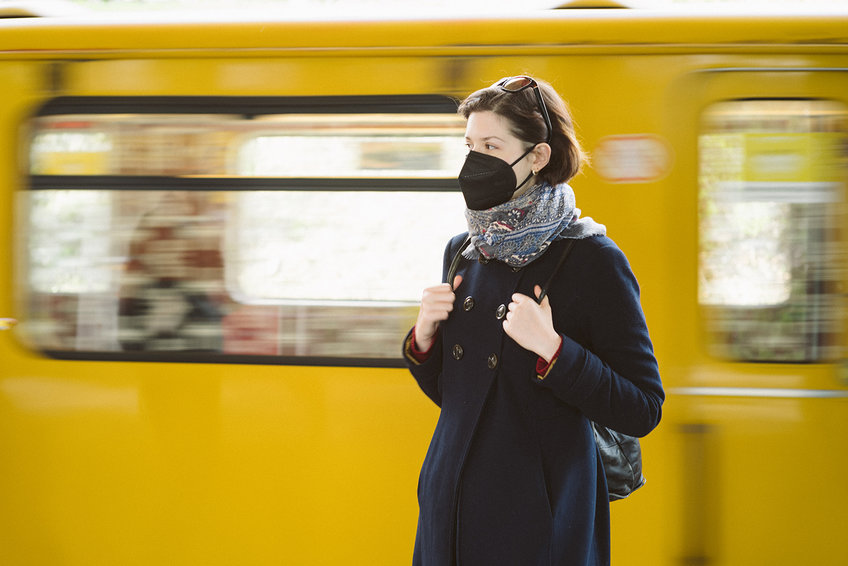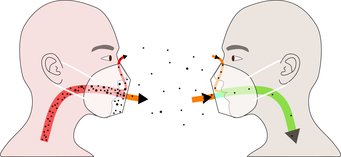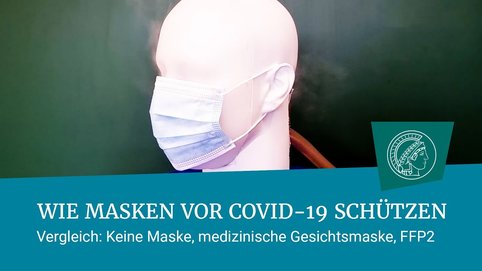How well masks protect
A detailed study shows the maximum risks of being infected by the coronavirus for different scenarios with and without masks
Three metres are not enough to ensure protection. Even at that distance, it takes less than five minutes for an unvaccinated person standing in the breath of a person with Covid-19 to become infected with almost 100 percent certainty. That's the bad news. The good news is that if both are wearing well-fitting medical or, even better, FFP2 masks, the risk drops dramatically. In a comprehensive study, a team from the Max Planck Institute for Dynamics and Self-Organisation in Göttingen has investigated to what extent masks protect under which wearing conditions. In the process, the researchers determined the maximum risk of infection for numerous situations and considered several factors that have not been included in similar studies to date.

The Göttingen team was surprised at how great the risk of infection with the coronavirus is. "We would not have thought that at a distance of several metres it would take so little time for the infectious dose to be absorbed from the breath of a virus carrier," says Eberhard Bodenschatz, Director at the Max Planck Institute for Dynamics and Self-Organisation. At this distance, the breathing air has already spread in a cone shape in the air; the infectious particles are correspondingly diluted. In addition, the particularly large and thus virus-rich particles fall to the ground after only a short distance through the air. "In our study we found that the risk of infection without wearing masks is enormously high after only a few minutes, even at a distance of three metres, if the infected persons have the high viral load of the delta variant of the Sars-CoV-2 virus," says Eberhard Bodenschatz. And such encounters are unavoidable in schools, restaurants, clubs or even outdoors.
Well-fitting FFP2 masks reduce the risk at least into the per thousand range.
As high as the risk of infection is without mouth-nose protection, medical or FFP2 masks protect effectively. The Göttingen study confirms that FFP2 or KN95 masks are particularly effective in filtering infectious particles from the air breathed - especially if they are as tightly sealed as possible at the face. If both the infected and the non-infected person wear well-fitting FFP2 masks, the maximum risk of infection after 20 minutes is hardly more than one per thousand, even at the shortest distance. If their masks fit poorly, the probability of infection increases to about four percent. If both wear well-fitting medical masks, the virus is likely to be transmitted within 20 minutes with a maximum probability of ten percent. The study also confirms the intuitive assumption that for effective protection against infection, in particular the infected person should wear a mask that filters as well as possible and fits tightly to the face.

The infection probabilities determined by the Max Planck team indicate the upper limit of the risk in each case. "In daily life, the actual probability of infection is certainly 10 to 100 times smaller," says Eberhard Bodenschatz. This is because the air that flows out of the mask at the edges is diluted, so you don't get all the unfiltered breathing air. But we assumed this because we can't measure for all situations how much breathing air from one mask wearer reaches another person, and because we wanted to calculate the risk as conservatively as possible," Bodenschatz explains. "Under these conditions, if even the largest theoretical risk is small, then you're on the very safe side under real conditions." For the comparative value without the protection of a mask, however, the safety buffer turns out to be much smaller. "For such a situation, we can determine the viral dose inhaled by an unprotected person with fewer assumptions," says Gholamhossein Bagheri, who as a research group leader at the Max Planck Institute for Dynamics and Self-Organization who is the lead author of the current study.
"Masks in schools are a very good idea"
In their calculations of the risk of infection, the Göttingen team considered a number of factors that had not previously been included in comparable studies. For example, the researchers investigated how a poor fit of the mask weakens the protection and how this can be prevented. "The materials of FFP2 or KN95 masks, but also of some medical masks, filter extremely effectively," says Gholamhossein Bagheri. "The risk of infection is then dominated by the air coming out and going in at the edges of the mask." This happens when the edge of the mask is not close to the face. In elaborate experiments, Bagheri, Bodenschatz and their team measured the size and amount of respiratory particles that flow past the edges of masks that fit differently. "A mask can be excellently adapted to the shape of the face if you bend its metal strap into a rounded W before putting it on," says Eberhard Bodenschatz. "Then the infectious aerosol particles no longer get past the mask, and glasses no longer fog up either."
How masks protect against Covid-19
The team also considered that droplets that people spread when they breathe or speak dry while in the air and become lighter. This means that they remain in the air longer but also have an increased virus concentration as equal size droplets directly after release. When inhaled, the opposite happens: the particles take up water again, grow like a drop in the cloud and therefore deposit more easily in the respiratory tract.
Although the detailed analysis by the Max Planck researchers in Göttingen shows that tight-fitting FFP2 masks provide 75 times better protection compared to well-fitting surgical masks and that the way a mask is worn makes a huge difference; even medical masks significantly reduce the risk of infection compared to a situation without any mouth-nose protection at all. "That's why it's so important for people to wear a mask during the pandemic," says Gholamhossein Bagheri. And Eberhard Bodenschatz adds, "Our results show once again that mask-wearing in schools and also in general is a very good idea."














